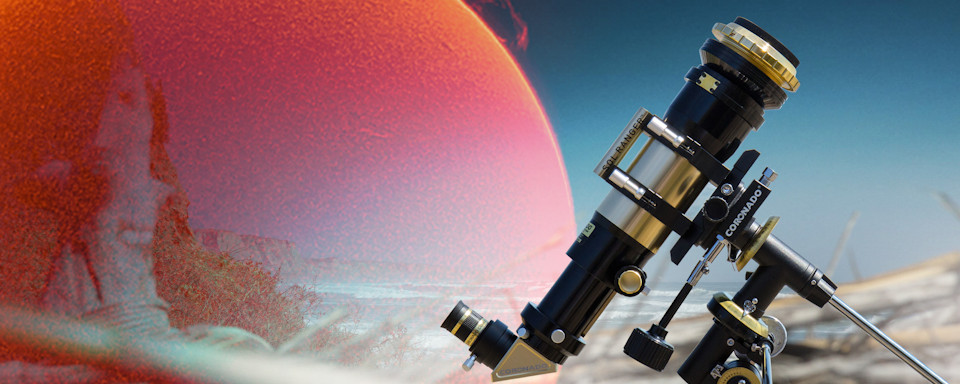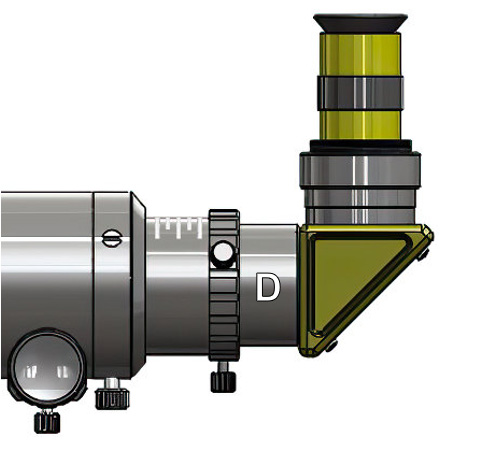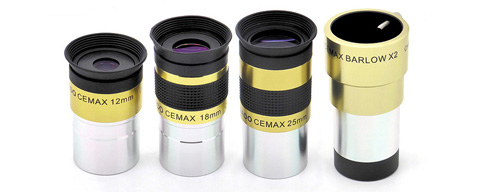Introduction
This article considers the Coronado SolarMax III series solar scopes and explains how to get the most out of these scopes
covering them in terms of their components, accessories, observation and basic imaging requirements and finally provisions
for their safe storage and transportation.

Coronado SolarMax III.
Focuser
The dual speed focuser incorporates an extendable internal drawtube (D) that may need to be extended or retracted depending on the type of use i.e., observation, camera type, use of bino-viewer etc. Otherwise, you may be unable to reach focus.
For observation purposes and with an eyepiece attached to the scope’s diagonal, you could start with extending the internal drawtube (D) by around 3cm.
Note in the example on the right that both the focuser drawtube and internal drawtube having been partially drawn-out/extended, typically necessary so as to reach focus with an eyepiece.

SolarMax III focuser.
Etalons
Prior to a session, ensure that the etalon housings (A) of your SolarMax III solar scope have not come loose since this can affect performance. This can sometimes happen in transit when an item has been subject to continuous vibration. If an etalon housing (A) has become loose, grab the etalon housing at (B) and simply turn it anti-clockwise as you stand behind the eyepiece until it feels tight.

Coronado SolarMax III etalons.
Note that the knurled clocking-ring (C) is fixed in place by three grub screws. This clocking is done at the factory, and is strongly advised that you do not remove it or re-clock it since this could adversely affect image quality. Considering that re-clocking requires extensive experience and a good level of familiarity with the scope and Solar observation in general re-clocking should only be attempted by experienced users and only if there was a need. Please contact us before you attempt re-clocking.
If it became necessary to re-clock the scope, it is advised to mark the original clocking position before you start and then proceed to see if a better quality can be achieved by re-calibrating the clocking between the etalons i.e., their rotational relative positions. Re-clocking only applies to double-stacked SolarMax III solar scopes.
Visual observation & imaging conditions
There are several factors that will affect the quality of the image through any Solar scope and it is therefore important being aware of them since some can be mitigated to an extent.
High levels of humidity and air-borne dust will affect the quality of the image, especially when the Sun is lower in the sky. Also, haze and thin clouds will soften the image and sometimes can have a dramatic effect.
Observing in late morning, say between 10:00am and 12:00pm, is preferable to doing so in the late afternoon. As the ground heats up, it radiates heat as do the roofs of building so, make certain your line of sight does not pass just over a building.
Please note that you must always use the scope with the diagonal in place, whether you observe or image with it.
Caution: Using the scope without the diagonal in place could permanently damage your eyes and any equipment attached to it.
Accessories
The SolarMax III solar scopes will accept standard 1.25” eyepieces and will come in focus with a standard bino-viewer, DSLR or C/CS type video camera. All these must always be attached to the scope’s diagonal.
The quality and type of eyepieces used with solar scopes in general is very important. Simpler optical designs that use high index glass, take advantage of baffling, darkened lens edges and appropriate coatings can significantly increase image quality. Inadequate and inappropriate designs will absorb/reflect valuable H-a light and be subject to various artifacts and glare readily visible in the eyepiece.
We highly recommend using the Coronado CEMAX range of eyepieces in conjunction with any Coronado solar scope.
CEMAX eyepieces have been specifically designed for use with Coronado H-alpha solar scopes. These specialty eyepieces use optimised coatings to enhance contrast, minimize glare and also afford excellent contrast for planetary viewing. A CEMAX 2x Barlow is also available.

Coronado CEMAX eyepieces & barlow lens.
Transporting a SolarMax III solar scope
It is important to keep the transit box the scope came in since this will protect it from knocks if there was a need to ship the scope by say a courier service or similar. Otherwise, the padded aluminium case the scope came with would be ideal for everyday use and also for storing on-site.
When the scope is not in use and will travel with it, please have the RichView tuning ring (E) set to the minimum pressure by turning it fully clockwise when you are looking from the eyepiece side. This will prevent the etalon from sudden knocks that could theoretically dislocate it. In such situations it is also good practice to fully close the T-Max Tuner/s.

Setting RichView tuning at minimum pressure.
User Manual
When in doubt, please consult the scope’s instruction manual and do not make assumptions. The SolarMax III is a sophisticated instrument and should only be used as outlined in its manual. If uncertain, please contact us for advice.
Related topics:
how-to guide, SolarMax III, solar





